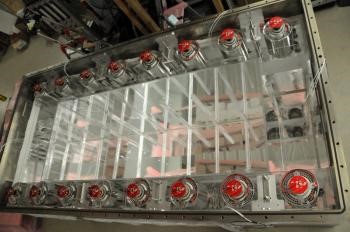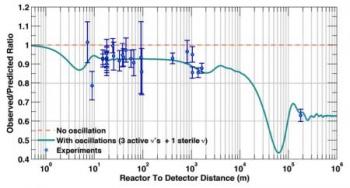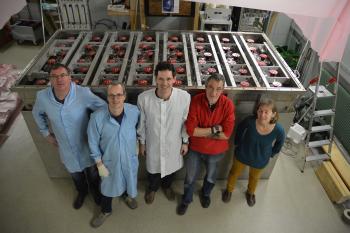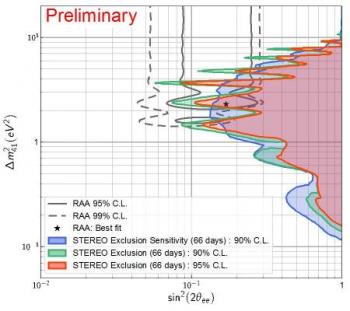
STEREO is a neutrino detector made up of six scintillation liquid cells that takes data 10 m from the Grenoble high neutron flux reactor (ILL).
The STEREO experiment presented its first physics results at the 53rd Rencontres de Moriond1. STEREO is a neutrino detector made up of six scintillation liquid cells that has been measuring, since November 2016, the electronic antineutrinos produced by the Grenoble high neutron flux reactor 10 metres from the reactor core. The existence of a fourth neutrino state, called sterile neutrino, could explain the deficit in neutrino flux detected at a short distance from nuclear reactors compared to the expected value. Indeed, this anomaly could result from a short-range oscillation that would result in less expected electronic antineutrinos being detected because they would disappear into sterile neutrinos. The first results obtained in 2018 after 66 days of data exclude a significant part of the parameter space. The experiment will continue to take data until the end of 2019. By multiplying the statistics by four and minimizing systematic analysis errors, STEREO will be able to shed light on the existence of this 4th neutrino family.
153rd Rencontres de Moriond Electroweak session
Sterile neutrinos
While they are among the most abundant particles in the universe, neutrinos are extremely difficult to detect. They originate in the heart of the stars or in the most violent phenomena of our universe, but can also be produced by particle accelerators or, as in the case of the STEREO experiment, in the heart of nuclear reactors.
Neutrinos have no electrical charge and interact very weakly with matter. Today we know 3 types or flavours: electronic neutrino, muonic neutrino and tauic neutrino. An amazing discovery made 20 years ago showed that neutrinos can change flavor, i.e. change from one flavor to another as they travel. This phenomenon, called "neutrino oscillation" was awarded the Nobel Prize in Physics in 2015.
Are there more than 3 types of neutrinos?
The interest in this issue gained new strength in 2011 when researchers2 noted that two sets of previously unexplained experimental results could be interpreted by transforming neutrinos into a 4th type of neutrino never observed before (Figure 1). The existence of a fourth neutrino state, called sterile neutrino, could explain the deficit in the neutrino flux detected at a short distance from nuclear reactors compared to the expected value. Indeed, this anomaly could result from a short-range oscillation that would result in less expected electronic antineutrinos being detected because they would disappear into sterile neutrinos.
This neutrino, called "sterile" because without direct interaction with matter, would have a mass around the eV, much larger than that of the other three neutrinos already known and its discovery would be a major advance in particle physics. Several experiments, including STEREO, aim to confirm or disprove this hypothesis.
2G. Mention et al, Phys. Rev. D83 (2011) 073006, Th. A. Mueller et al, Phys.Rev. C83 (2011) 054615

Figure 1 : in the case of neutrinos emitted by nuclear reactors, a deficit has been identified by research works carried out at IRFU. Following a re-evaluation of the predicted neutrino rates, all the values measured between 10 and 100 m are clearly deficient compared to the prediction (red dotted line). The existence of a sterile neutrino could explain this deficit.

The six STEREO cells are 40 cm wide, which makes it possible to follow the oscillation of the neutrinos over 2.4 m
STEREO: an experience as close as possible to reactors
This project consists of measuring the oscillation of electronic antineutrinos with a six-cell segmented detector, placed about 10 m from the core of the Grenoble high neutron flux reactor. The six Stereo cells are 40 cm wide, which makes it possible to follow the oscillation of the neutrinos over 2.4 m. The antineutrinos detection technology uses scintillation liquids doped with Gadolinium, as is the case with the Double Chooz and Nucifer detectors. The capture of a neutrino by a hydrogen atom in the liquid results in the emission of a positron and a neutron delayed by a few tens of microseconds. Since the end of 2016, data are being acquired with the detection of nearly 400 antineutrinos every day. The first results obtained in 2018 after 66 days of data exclude a significant part of the parameter space.
The IRFU through the Nuclear Physics Departments (DPhN), the Systems Engineering Department (DIS) and the Detector Electronics for Physics Department (DEDIP) is particularly involved in this project with responsibility for STEREO's core: the internal detector tank and its division into cells by reflective acrylic walls.
| STEREO is a Franco-German experiment observing neutrinos from the core of the Laue-Langevin Institute's nuclear research reactor in Grenoble. The experiment was designed and implemented by the research groups and technical services of the Irfu-CEA in Saclay, the Laue-Langevin Institute (ILL), the Annecy Laboratory for Particle Physics (LAPP), the Laboratory of Subatomic Physics and Cosmology (LPSC) in Grenoble and the Max-Planck-Institut für Kernphysik (MPIK) in Heidelberg, Germany. |
Results that weaken sterile neutrinos hypothesis
The first results of the STEREO experiment presented at the Moriond Meetings exclude a significant part of the parameter space expected for the existence of a hypothetical 4th neutrino (see Figure 2), but the worldwide quest for sterile neutrino continues.
STEREO will indeed gain in precision by accumulating 4 times more data by the end of 2019 and the competing projects currently underway will shed additional light on this hypothetical 4th neutrino.
Thanks to the characteristics of the ILL reactor core, highly enriched in 235U, the STEREO experiment will also be able to provide a new measurement of the neutrino spectrum emitted by the fission of this isotope, which is very important for all neutrino experiments with reactors.
Contacts: David Lhuillier (DPHN), Caroline Lahonde-Hamdoun (DEDIP)
The STEREO project is financially supported by
• the National Research Agency (ANR) for the period 2013-2017 (including a study and construction phase that will have lasted 3 years and then the current operating phase),
• but also in France by the CNRS, UGA, CEA and Institut Laue-Langevin (ILL, Grenoble);
• in Germany by the Max Plank Institute.
• the project also benefits from the support of the ENIGMASS and P2IO labex for the hosting of post-doctoral fellows and trainees.

Figure 2: The possible values of the 4th neutrino parameters are delimited by the black curves, with the star marking the most likely case. The vertical axis is related to its mass and the horizontal axis to the amplitude of its mixing with the neutrinos emitted by the reactor. The red and green regions are rejected by the STEREO experiment measurements with different confidence levels (95% and 90%). The blue region represents the theoretical rejection sensitivity of the STEREO experiment for a statistical precision corresponding to 66 days of data.
• Innovation for detection systems › Detectors for both infinite physics The ultimate constituents of matter › Neutrino Physics
• Institute of Research into the Fundamental Laws of the Universe • The Electronics, Detectors and Computing Division • The Nuclear Physics Division • The Systems Engineering Division
